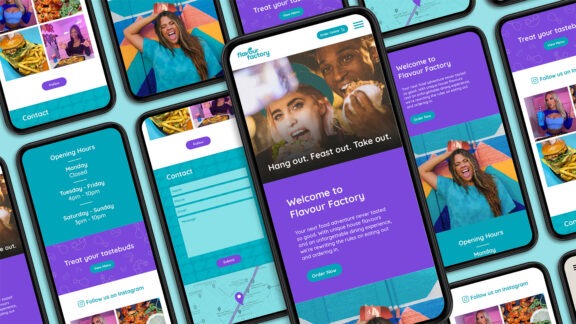Brand consistency – across all of your marketing and sales touchpoints – builds recognition and develops trust among your customers. Trust is key to authenticity: it helps you to attract and retain clients, build loyalty, and even create advocates for your brand. Any deviation from your brand can start to sow the seeds of doubt, which in turn erodes trust.
Not every business can afford to have all of their marketing collateral created and managed by a branding agency. But even if you do use an agency, there’s still a whole team of marketers, designers and content creators all working on different outputs across multiple marketing channels. And the more people involved, the greater the potential for inconsistency.
So what gives you the best chance of maintaining brand consistency as your business grows?
In this article, we’ll run through 5 ways to maintain brand consistency.
1. Have a set of brand guidelines
A great starting point is to create a robust document outlining all of your brand guidelines in detail. A good brand guidelines document will convey your brand strategy; what you do, how you do it, why you do it, who you do it for, and how you talk about what you do. You’ll include your brand values, purpose, and personality.
The guidelines document will also detail how to express your brand’s visual and verbal identity, including:
- Your brand logo and how it should be used
- Your fonts
- Your colour palette
- Your styling for photography, illustration and icons
- Your writing and tone of voice guidelines
- Examples of how everything comes together (and what wouldn’t be right)
Initially, perhaps you’ll work closely with your branding agency, who will provide your guidelines along with the majority of your marketing assets. But as your business grows, you’ll need to consider who else will be working on your brand – internally and externally – and that’s where your brand guidelines will really help
You may find yourself briefing other external partners: a PR agency; a web design agency; a social media agency; a product launch or events company… Your brand guidelines will ensure consistency, save you having to repeat yourself endlessly, and require each supplier to be accountable to you in the way they interpret your brand. You’ll almost certainly have people creating marketing and design content in-house, too. You may therefore need to put in place more detailed guidance or templates for people who are less accustomed to brand.
You’ll almost certainly have people creating marketing and design content in-house, too. You may therefore need to put in place more detailed guidance or templates for people who are less accustomed to brand management, providing a stronger foundation and platform for consistency.
Other considerations for your guidelines document:
- Employee engagement: Communicating with your employees and engaging them with the brand (after all, your employees are often the face of your brand).
- Social media: Creating content for social media often requires a special approach, especially with personality, tone of voice, character limits and differences between platforms.
- Content marketing guidelines: Creating content regularly for your website, especially for inbound marketing campaigns.
How often should a brand guidelines document be updated?
Whilst brand consistency is important, a brand should be allowed to evolve while staying true to its principles. Once a year is a sensible time to review your guidelines document and ask yourself if it still reflects your current situation. How have people responded to using it? Would more examples or guidance be useful?
2. Appoint a brand guardian
With a wide range of people working on different aspects of your marketing collateral, different interpretations of your brand guidelines will be inevitable. Whilst this itself can be part of the way a brand evolves, there’s a balance to be struck between stretching the boundaries and having them fall apart.
This is where a brand guardian comes in. They act as a central point for reviewing your brand outputs and assessing the performance of external suppliers. Your brand guardian will be very familiar with your brand guidelines and will have a keen eye for detail. They could be someone within your own company, or someone at your trusted brand agency. Either way, their role is crucial in maintaining your brand’s consistency across multiple touchpoints.
Your brand guardian should be good at communicating, keeping everyone in the loop as your brand assets evolve, sharing knowledge and learnings, and updating templates or guidelines as required, whilst also letting everybody know where. Your brand guardian should be open to communication and queries; being approachable will help your team to make the most of their help, and means they’ll feel able to share their questions and outputs.
3. Have a complete set of brand assets or templates
An easy way to maintain consistency is to create brand templates for your regular marketing or sales activities. Templates can be very efficient for rapidly creating assets which are on-brand and maintain a high standard of presentation. Here are some examples of templates you should consider:
- PowerPoint/Keynote presentation: A basic template with cover, dividers and content examples is a good starting point, but could a standard sales presentation format be set? What are all the different types of content that you might need to display? Creating more examples will keep presentations consistent.
- Case study templates: A good case study template will provide a structure for gathering the content. With a consistent format it becomes easier to create stronger case studies which also work well as a suite.
- Social media posts: As part of a content plan, there may be a regular set of content types that suit a templated format. This makes them easier to create and provides audience recognition for a certain type of post, such as testimonials or case studies. You may also want to find a way of identifying images and content as yours, so they can’t be ‘stolen’.
- Leaflets/brochures: These templates will often provide more flexibility for different types of content, so they’re more of a starting point to inspire a designer.
- HTML email templates: These could be newsletters, sales emails, or part of your e-commerce automated flows. Templates can be created for most email platforms, such as Mailchimp. A branded email template will allow more tailoring for your brand than an in-built template option.
The danger of templating software
With the rise of theme sites and other templating platforms, there has never been an easier time to dabble in design. These sites often provide great-looking templates and themes and promise a simple editing experience. Whilst it’s possible to use these starting points to create good-looking content, the output can often blend into the crowd rather than standing out from it. They can also lead to content that feels disjointed when compared to the brand’s desired look and feel, weakening brand consistency. A well-crafted set of on-brand templates will help keep your content unique and avoid this pitfall.
4. Plan your content
Creating a robust brand marketing strategy will help you plan out content for the months and years ahead, which can itself help with consistency. Content-planning sessions should focus on the key pillars aligned to your brand’s purpose and values.
Here at Studio North, we facilitate such sessions for our clients, who have come to appreciate just how much these sessions help to build out a plan for the year. Knowing what type of content, you’re going to create will help with creating templates and structures for maintaining consistency. With all the ideas mapped out, a content calendar can be created to help structure and plan the content for the year – making sure nothing is missed out or overly repeated.
Of course, there will always be an element of reactive messaging, but with a clear plan for your regular content you’ll have more time to react to these and keep them on-brand, too.
5. Align your content to your proposition and values
Brand consistency isn’t just about how things look; it’s also about what you say, and how that makes your customers or clients feel. If any of your messaging or your approach goes against your brand values, it sends mixed messaging. Always ensure that you to refer to your brand values and propositions regularly, and use them as a checklist for your content.
Do you need help maintaining your brand consistency?
We work with our clients’ brands in several different ways. As a multiple-award-winning brand agency, we’re trusted to lead and manage brands and marketing activity. Where requested, we will act as brand guardians and provide support where clients manage some or all of their brand activity in-house. Whatever support you need, we’d welcome a chat to discuss your challenges and see how we can help.








